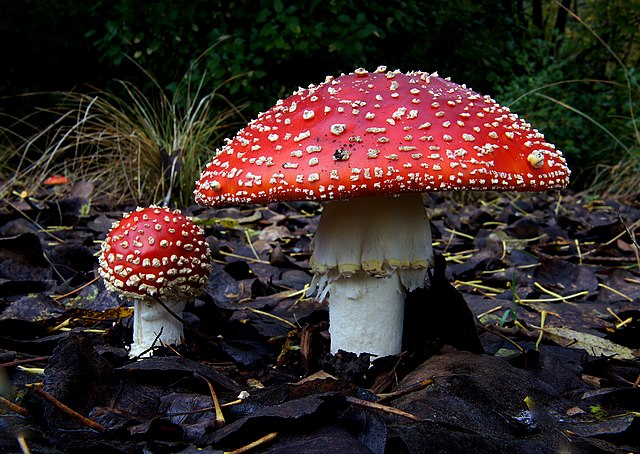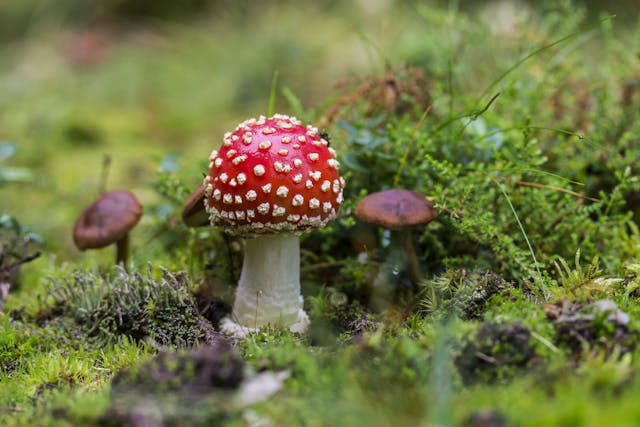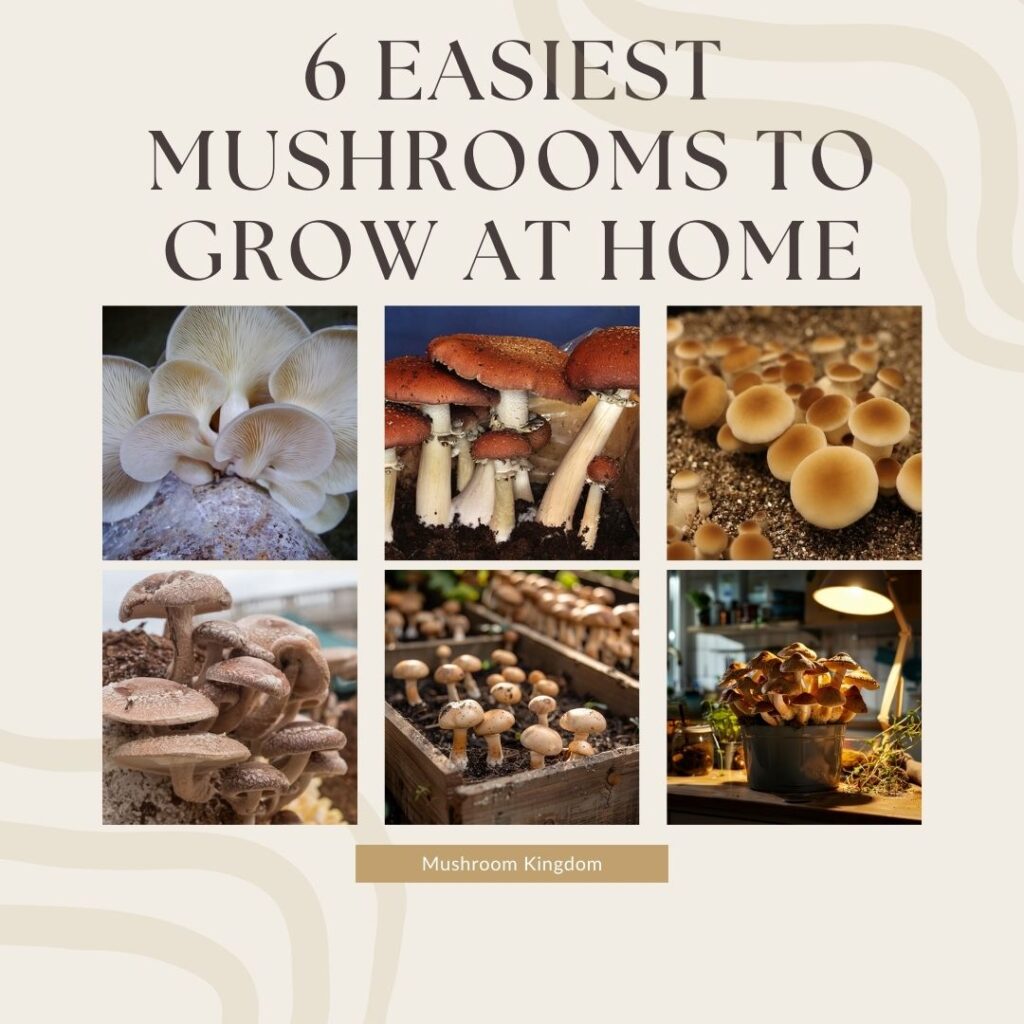Amanita muscaria, also known as the “fly agaric” mushroom, is a striking red-capped fungus found in forests worldwide, known for its toxic and hallucinogenic properties when ingested.
Identifying Amanita Muscaria Mushroom
Identifying Amanita muscaria, commonly known as the fly agaric mushroom, involves observing several distinct features. Here’s a detailed guide to help you recognize this mushroom.
Cap
The cap is one of its most striking features. It starts out bright red to orange-red, although older mushrooms can fade to yellow or orange.

This color change is important to note, as it can help differentiate younger from older specimens. The cap size typically ranges from 8 to 20 centimetres (3 to 8 inches) in diameter.
When young, the cap is usually spherical or dome-shaped, but it flattens out as the mushroom matures. The surface of the cap is smooth to slightly sticky when wet, and it is adorned with white, cream, or yellowish warts or spots.
These spots are remnants of the universal veil that once enveloped the young mushroom.
Gills
Next, examine the gills underneath the cap. They are white, although sometimes they can have a yellowish tint.
The gills are free from the stem or only slightly attached to it, meaning they do not run down the stem. They are also densely packed together.
Stem (Stipe)
The stem is another key feature. It is white, but the base can sometimes appear yellowish.
The stem’s height ranges from 5 to 20 centimeters (2 to 8 inches), and it is typically 1 to 2.5 centimeters (0.4 to 1 inch) thick. The stem is cylindrical, tapering slightly towards the top, and has a bulbous base.

One of the distinctive features of the stem is the ring (annulus) around the upper part, which is white or yellowish. Additionally, the base often has concentric rings or a volva, which is a cup-like structure.
Spore Print
If you need further confirmation, you can take a spore print. The spore print of Amanita muscaria is white, adding another layer of verification to your identification process.
Habitat
Amanita muscaria is commonly found in coniferous and deciduous woodlands. It forms symbiotic relationships with trees such as birch, pine, spruce, and fir. This mushroom typically appears in late summer and persists through the autumn months.
Is Amanita Muscaria Legal?
In the United States, Amanita muscaria is not classified as a controlled substance at the federal level. Therefore, it is legal to possess and use it in most states. However, some states have local laws that may restrict its use or sale. For instance, Louisiana has specific regulations that ban the cultivation, sale, and possession of hallucinogenic mushrooms, including Amanita muscaria.
Europe
In Europe, the legal status differs from country to country. For example, in the United Kingdom, Amanita muscaria is not classified as a controlled substance, making it legal to possess and use. In contrast, countries like the Netherlands have more stringent laws. While fly agaric is not explicitly banned, its sale is prohibited under regulations that govern psychoactive substances.
Canada
In Canada, Amanita muscaria is not listed as a controlled substance under the Controlled Drugs and Substances Act. Therefore, it is legal to possess and use. However, its sale may be subject to regulations under food and drug laws, especially if it is marketed for consumption.
Australia and New Zealand
In Australia, Amanita muscaria is classified as a Schedule 9 substance under the Poisons Standard, making it illegal to possess, use, or sell. New Zealand has similar restrictions, categorizing Amanita muscaria as a Class C controlled drug, which prohibits its possession and use without proper authorization.
Asia
The legal status in Asian countries varies widely. For example, in Japan, fly agaric is legal to possess and use, but its sale can be restricted under local regulations. Meanwhile, in countries like South Korea, it is classified as a controlled substance, making its possession and use illegal.
Is Amanita Muscaria Edible?
Amanita muscaria is not traditionally considered edible in its raw form due to its toxic and psychoactive properties. However, with proper preparation, some people do consume it. Here’s a detailed explanation of its edibility and the associated risks and preparations.
Toxicity
Firstly, the mushroom contains several toxic compounds, primarily ibotenic acid and muscimol. These substances can cause a range of symptoms, including nausea, vomiting, dizziness, hallucinations, and in severe cases, seizures and coma. Therefore, consuming the mushroom raw or improperly prepared can be dangerous.

Traditional Preparation Methods
Despite its toxicity, some cultures have developed methods to detoxify Amanita muscaria and make it safer for consumption. These methods typically involve extensive preparation to reduce the levels of harmful compounds.
- Boiling: The most common method is to boil the mushrooms in water for an extended period. This process helps to leach out the toxic compounds. After boiling, the water, which now contains the toxins, is discarded. The mushrooms are then rinsed and sometimes boiled again in fresh water to ensure thorough detoxification.
- Drying: Another method involves drying the mushrooms. Drying can partially break down the toxic compounds, although this method is generally considered less effective than boiling.
Does Amanita Muscaria Make You Trip
Amanita muscaria can indeed cause hallucinogenic effects, which many describe as “tripping.” This mushroom contains psychoactive compounds such as ibotenic acid and muscimol. These substances interact with the central nervous system, leading to various mental and physical effects.
Psychoactive Compounds
Firstly, ibotenic acid and muscimol are the primary compounds responsible for the hallucinogenic effects. Ibotenic acid acts as a prodrug, converting to muscimol in the body. Muscimol is the main agent that causes the psychoactive effects.
Onset and Duration
When someone ingests fly agaric, the onset of effects typically occurs within 30 minutes to two hours. The experience can last anywhere from 4 to 10 hours, depending on the dosage and individual sensitivity.
Hallucinogenic Effects
The hallucinogenic effects can vary widely among individuals. Commonly reported experiences include vivid visual and auditory hallucinations, changes in perception of time and space, and a sense of euphoria. Some users also report feeling disconnected from their surroundings or experiencing profound spiritual or mystical insights.
Physical Effects
Alongside the hallucinogenic effects, Amanita muscaria can cause a range of physical symptoms. These may include nausea, vomiting, muscle twitching, dizziness, and drowsiness. In some cases, users might experience sweating, salivation, and ataxia (loss of coordination).
How to Grow Amanita Muscaria
Growing Amanita muscaria, the fly agaric mushroom, can be challenging due to its specific symbiotic relationship with certain trees. However, with the right conditions and careful attention, it is possible. Here’s a step-by-step guide to help you cultivate Amanita muscaria.
Understand the Symbiotic Relationship
First, it’s important to understand that fly agaric forms a mycorrhizal relationship with trees such as birch, pine, spruce, and fir. This means the mushroom needs the roots of these trees to grow and thrive. Therefore, you should plan to cultivate it near suitable host trees.
Gather Spores
Begin by collecting spores. You can obtain these from mature mushroom caps. Place a cap on a piece of white paper with the gills facing down and cover it with a bowl. After 24 hours, spores will drop onto the paper. Alternatively, you can purchase spore prints or spore syringes from a reputable supplier.
Prepare the Growing Site
Next, choose a suitable outdoor location near the base of your selected host trees. The soil should be well-drained and rich in organic matter. You might need to amend the soil with compost or leaf litter to mimic the natural forest floor.
Inoculate the Soil
To inoculate the soil with Amanita muscaria spores, mix the spores with water to create a spore slurry. Then, pour the slurry around the base of the host trees. Alternatively, you can mix the spores with a growing medium such as peat moss and spread this mixture around the trees.
Maintain Proper Conditions
After inoculating the soil, it’s crucial to maintain the right conditions for the mycelium (the mushroom’s underground network) to grow. Keep the soil moist but not waterlogged, especially during dry periods. Additionally, maintain a layer of leaf litter or mulch around the inoculated area to protect the mycelium and retain moisture.
Patience and Observation
Growing Amanita muscaria requires patience, as it can take several months to a few years for the mushrooms to appear. Regularly check the inoculated area for signs of mushroom growth, particularly during the late summer to autumn months, which is their typical fruiting season.


